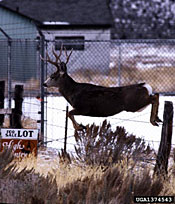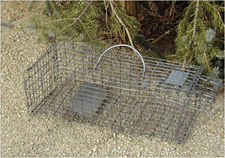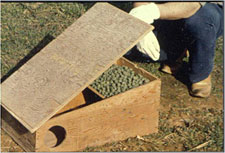Vertebrate Pest Management
Vertebrate pests include animals with a backbone, such as ground squirrels, mice and pigeons.
Exclusion
Exclusion is the practice of keeping the pest out of or away from crops, ornamental plants, buildings, etc. Using barriers, such as fencing and durable materials, to plug entrances into buildings or prevent animals from accessing crops, gardens, lawns or landscape plants, are examples of exclusion practices. Fences must be sized according to the type of pest to be excluded.

To be effective, exclusion fences for deer must be at least 6 feet tall. Some experts recommend the fence be 7 to 8-feet tall.
Photo credit: Terry Spivey, USDA Forest Service, Bugwood.org
Sanitation
This is especially important for areas like kitchens, residences and areas where animals are kept. Eliminate food and water sources. Store food and animal feeds, grain and seed in rodent-proof containers. Repair leaky pipes. Sanitation is also important for managing vertebrate pests in yards. Avoid leaving windfall apples or other fruits and vegetables where they are accessible to pests. Cover your compost pile.
Trapping
There are several types of kill traps and live traps available for most vertebrate pest species. It is essential to choose the proper trap and learn the correct way to use it. Live trapping and releasing the pest is neither acceptable nor legal. Individuals who release live-trapped animals are moving the pest problem and sometimes diseases like rabies, distemper or plague along with them. Live trapping followed by an approved method of euthanasia is recommended. The American Veterinary Medical Association has specific guidelines for euthanasia.

When using live traps, do NOT relocate pest animals.
Photo credit: NDOA
Repellents
Repellants may be applied to valuable vegetation or can be used in areas where pests are known to frequent. They often don't work the way people expect them to work. Sunshine can break down the repellent, and sprinklers and rain can wash away the product. New growth on plants must be retreated, and animals may simply get used to the repellent.

Deer repellents can be attached to posts or fences.
Photo credit: Chazz Hesselein Alabama Cooperative Extension System, Bugwood.org
Rodenticide Baits
Baits such as seeds, grains and vegetation treated with rodenticides are used to control several types of vertebrate pests. Most baits must be applied in bait stations or underground within animal burrows to lessen the risk of killing of non-target species. Pesticide labels describe methods for applying the bait. Pesticides used include strychnine, zinc phosphide and various anticoagulants. Strychnine may only be applied underground.

Use an appropriate bait station to reduce the chances of killing non-target animals.
Photo credit: NDOA
Fumigants
Smoke bombs and various types of internal combustion engines produce poison gases, including carbon monoxide, that can be used as fumigants. This is a very dangerous method that should be avoided by homeowners. To be effective, all burrow entrances must be blocked. When using smoke bombs, avoid areas near structures, haystacks, etc. Aluminum phosphide fumigants are available either as tablets or pellets. When applied in rodent burrows, they produce phosphine gas, which is deadly. Applied improperly, aluminum phosphide has resulted in numerous human deaths. To purchase, apply or supervise the use of this pesticide, applicators must successfully pass the state rodent burrow fumigation certification category. Homeowners cannot use these products.
Hefner, M.
2019,
Vertebrate Pest Management,
Extension | University of Nevada, Reno. IP


